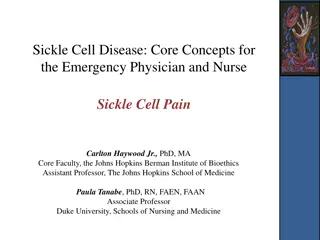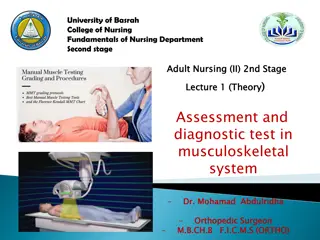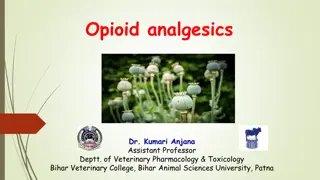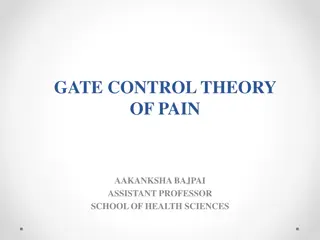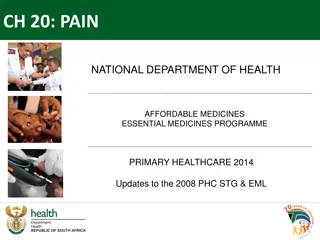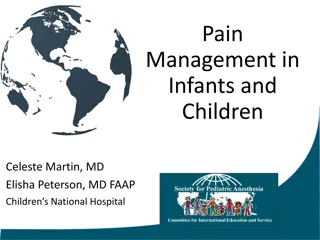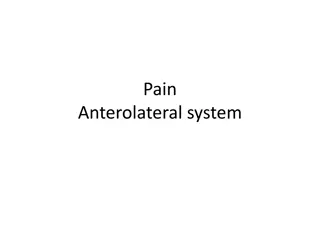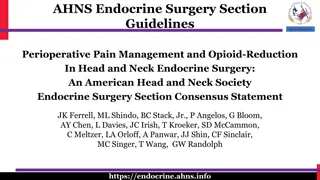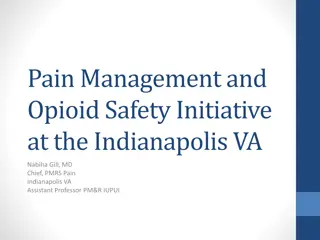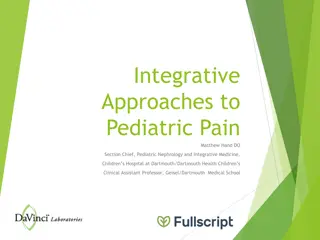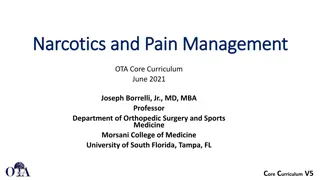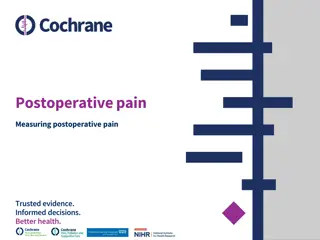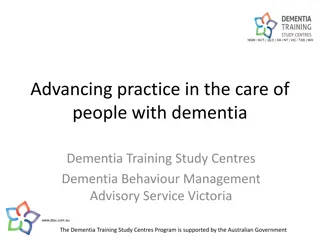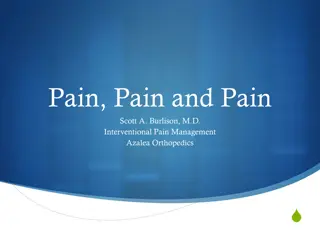Comprehensive Overview of Pharmacological Pain Management Strategies
This comprehensive overview covers various aspects of pharmacological pain management, including behavioral measures for patients unable to self-report pain, building pain regimens, NSAIDs use and associated risks, NSAIDs and COX selectivity, clinical presentation of pain symptoms, gabapentinoids for neuropathic pain, and SNRIs like duloxetine for neuropathic pain and other conditions. The content includes dosing, titration schedules, efficacy, adverse effects, and more.
Uploaded on Nov 23, 2024 | 4 Views
Download Presentation

Please find below an Image/Link to download the presentation.
The content on the website is provided AS IS for your information and personal use only. It may not be sold, licensed, or shared on other websites without obtaining consent from the author.If you encounter any issues during the download, it is possible that the publisher has removed the file from their server.
You are allowed to download the files provided on this website for personal or commercial use, subject to the condition that they are used lawfully. All files are the property of their respective owners.
The content on the website is provided AS IS for your information and personal use only. It may not be sold, licensed, or shared on other websites without obtaining consent from the author.
E N D
Presentation Transcript
Pharmacological Pain Management Shawn Whitehead, PharmD, BCCCP Pharmacist Clinical Specialist Trauma / Burn
Behavioral Measures of Pain in Patients Unable to Self-Report Critical-Care Pain Observation Tool (CPOT) Score of >2 had a sensitivity of 86% and a specificity of 78% for predicting significant pain in post- op ICU adults
Building a Pain Regimen Ketamine Local analgesia Antispasmodic Neuropathic Pain Agent Acetaminophen + NSAID
NSAIDs Acute Kidney injury Incidence of AKI ketorolac vs. opioids Overall aOR: 1.09 (0.83 1.42) <5 days aOR: 1.00 (0.76 1.33) >5 days aOR: 2.08 (1.08 4.00), P = 0.03 Cirrhosis risk of bleeding and renal dysfunction CHF Sodium and H20 retention diuretic effectiveness Ketorolac analgesic dose ceiling of 10 mg Ann Intern Med. 1997;126:193-199
Building a Pain Regimen Ketamine Local analgesia Antispasmodic Neuropathic Pain Agent Acetaminophen + NSAID
Clinical Presentation Burning Pins and Needles (parasthesia) Tingling Numbness Electric shooting / shockwaves Crawling Temperature intolerance Allodynia
Gabapentinoids ADEs: sedation, dizziness, drowsiness, peripheral edema Pregabalin more quickly and extensively absorbed More linear dose response curve Gabapentin has saturable absorption Renal elimination! Addictive potential Gabapentin Starting dose: 100 - 300 mg TID Titration schedule Max daily: 3600 4800 mg Pregabalin Starting Dose: 75 mg once or twice daily Titration: q 2-3 days up to 600 mg/d
Serotonin and Norepinephrine Reuptake Inhibitors (SNRIs) Duloxetine Starting dose: 30 - 60 mg QD Titration: Every week to max 120 mg/d Effective for neuropathic pain AND osteoarthritis, chronic low back pain, and fibromyalgia Other indications: depression, anxiety, stress incontinence NNT ~5, NNH ~ 12 ADEs: nausea, insomnia, decreased appetite, dizziness, and hyperhidrosis, Venlafaxine
Tricyclic Antidepressants (TCAs) Amitriptyline & Nortriptyline Starting dose: 10 25 mg qhs 4 - 8 week trial MOA: inhibition of serotonin and norepinephrine reuptake, anti-histamine, anticholinergic, sodium channel antagonist NNT ~4, NNH ~9 ADEs: Anticholinergic CNS depression Cardiac conduction abnormalities (Na+ channel blocker) Orthostatic hypotension Serotonin syndrome
Building a Pain Regimen Ketamine Local analgesia Antispasmodic Neuropathic Pain Agent Acetaminophen + NSAID
Muscle Spasm Sudden, involuntary muscle contraction that tends to predominantly affect person s limbs or trunk. Flexor, extensor, adductor, or trunk spasms. Diazepam Starting dose: 2.5 mg TID Max: 40 mg/d ADEs: CNS and respiratory depression, dependence, and benzodiazepine withdrawal syndrome Fast onset, long duration, available PO, IV, rectal, intranasal Extensively hepatically metabolized to active metabolites
Antispasmodic Agents Observational, retrospective analysis of 18 39 yo patients with 3 or more rib fractures Methocarbamol 500 mg q6h Titrated up to 1500 mg q6h for pain control Pre-methocarbamol (N = 22) Post methocarbamol (N = 28) P value MME Day of admission 128 71 0.10 MME Day 2 103 75 0.08 Cumulative on Day 3 337 219 0.01 Hospital LOS, days 4 3 0.03
Building a Pain Regimen Ketamine Local analgesia Antispasmodic Neuropathic Pain Agent Acetaminophen + NSAID
Ketamine Blunt trauma patients with 3 rib fractures 2.5 mcg/kg/min (0.15 mg/kg/hr) vs. placebo for 48 hours Infusions started <12 hours from arrival to hospital MME utilization if ISS 15: Ketamine Placebo P-value 12 24 hours 50.5 94.3 0.03 24 48 hours 87.0 164.1 0.03 Total 180.3 328.5 0.048 No difference in secondary outcomes or adverse events noted Dosing based on IBW Excluded chronic opioid use and hx of psychosis or 3 psychotropic meds J Trauma Acute Care Surg. 2019;86: 181 188
Equivalent Analgesic Dosing Opioid IV Oral Codeine 120 mg 200 mg Fentanyl 0.1 mg (100 mcg) N/A Hydrocodone N/A 30 mg Hydromorphone 1.5 mg 7.5 mg Methadone Ask your Pharmacist Morphine 10 mg 30 mg Oxycodone N/A 20 mg Tolerance to one opioid does not mean tolerance to all opioids When converting from one to another, decrease dose ~25-50% Always have PRN agent available when titrating to account for difference in doses
Choosing an Opioid Most balanced = oxycodone Less histamine release Intermediate duration of action (4-6 hrs) Less dosage reductions renal impairment Only oral Safest Option = hydromorphone Least histamine release No opioid active metabolites Most preferable in renal impairment or hemodynamic instability IV or PO Short duration of action Procedural = Fentanyl Very fast onset and offset Very potent Hemodynamically stable Minimal ADEs Only IV Morphine Niche (venodilation) Pulmonary Edema Anxiolysis
Trama-DONT Tramadol Binds to mu opioid receptors so weakly doesn t contribute to analgesic effect. Affinity about 1/6000th that of morphine Inhibits reuptake of serotonin and norepinephrine Metabolite (ODT) had opioid activity 300x that of tramadol Requires CYP2D6 enzymatic conversion Wide genetic variation of CYP2D6 activity Increased risk of seizures Hypoglycemia Serotonin syndrome risk Venlafaxine
Postoperative Opioid Tapering Strong correlation exists between the duration of postsurgical opioid use and the subsequent development of opioid misuse. Each additional week of opioid use is associated with a 44% adjusted increase in the rate of misuse Preoperative use of >100 MMEs, benzos, antidepressants, history of depression, preexisting pain disorder, alcohol, and drug abuse risk of chronic opioid use after surgery Discharge opioid taper should be based on: expected time for recovery Inpatient opioid utilization over 24 48 hours prior to DC
Patients with Opioid Use Disorder on Methadone Confirm home methadone dose with methadone clinic ASAP Ask about compliance Ask about recent dosage changes Ask about duration in clinic Continue home methadone dose unless significant altered mental status Consider splitting home methadone dose to TID for improved analgesic coverage Watch for accumulation of medications that prolong QTc interval
Buprenorphine Pharmacology Partial Agonist High potency 1 mg buprenorphine 30 MME High affinity for the opioid receptor Potential for precipitating withdrawal Dose dependent half life J Addict Med. 2019 ; 13(2): 93 103.
Trauma Patients Intensive Care Unit and Floor Average of Total NON- Bupe MME/d Average Daily Min Pain Score Average Daily Max Pain Score Inpatient Buprenorphine Strategy Number of Patients Average APAP mg/d Average NSAID mg/d Average Pain Score 4 203.3 1909.8 0.0 3.2 8.8 6.5 Continued 21 118.9 2032.8 134.7 4.7 9.0 7.4 Held 9 88.1 2615.4 228.5 3.7 8.9 6.8 Reduced Total 34



